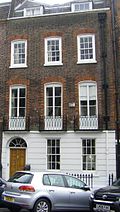Church Row
The Church Row is a street in the London district of Hampstead , District Camden . It is located between Frognal , a street to the west, and Fitzjohn's Avenue to the east. The only streets off Church Row are Frognal Gardens and Holly Walk , both of which head north. Much of the area south of the road is taken up by the Parish Church of St John-at-Hampstead , from which the road once took its name. The church's own grounds also include the St John-at-Hampstead cemetery, where a number of important personalities found their final resting place. These include the writer and historian Sir Walter Besant (1836–1901), the painter John Constable (1776–1837), the comedian Peter Cook (1937–1995), the children's author Eleanor Farjeon (1881–1965), the politician Hugh Gaitskell ( 1906–1963), the inventor John Harrison (1693–1776), the actress Kay Kendall (1926–1959), the writer George du Maurier (1834–1896) and his son, the actor Gerald du Maurier (1873–1934), the politician Frank Soskice , Baron Stow Hill (1902–1979) and the actor Adolf Wohlbrück (1896–1967).
Church Row is considered to be one of the most beautiful streets in London with an almost complete Georgian construction , the original details of which have largely been preserved to this day.
There is evidence that the street already existed under its current name in 1728. A number of artists and authors stayed here for a time.
Famous residents
The writer Anna Laetitia Barbauld (1743-1825) and her niece Lucy Aikin (1781-1864), who also worked as a writer, lived under number 8 around 1800 .
The writer HG Wells (1866-1946) lived in the house with number 17 between 1909 and 1912 . In 1964 the house was acquired by comedian Peter Cook (1937-1995), who received guests such as John Lennon , Paul McCartney , Peter Ustinov and Peter Sellers at this address .
The politician Sir Frank Soskice , Baron Stow Hill (1902–1979) lived under number 19 in the 1970s .
The architects Thomas Garner (1839–1906), George Frederick Brodley (1827–1907) and George Gilbert Scott the younger (1839–1897) lived under numbers 20, 24 and 26, who shared an office and ran the Watts & Co. Co founded. In addition, the writer and poet Lord Alfred Douglas (1870–1945) lived in house number 24 between 1907 and 1910 .
The writer and draftsman George du Maurier (1834-1896) lived in house number 27 between 1870 and 1874. His son Gerald du Maurier (1873-1934) was born at this time . The musician Cecil Sharp (1859–1934) later lived in the house.
The Scottish writer Compton Mackenzie (1883–1972) lived temporarily in 1910 in house number 28, which is located just off the east running Heath Street.
Individual evidence
- ↑ The information about the graves was taken from the report of the English language Wikipedia about the St John-at-Hampstead cemetery .
- ↑ Tour UK - Streets of London: Church Row ( Memento of the original from June 20, 2012 in the Internet Archive ) Info: The archive link was inserted automatically and has not yet been checked. Please check the original and archive link according to the instructions and then remove this notice. (English)
- ↑ Location: 17 Church Row, Hampstead, London (accessed August 20, 2011)
- ↑ Christopher Wade: The Streets of Hampstead . Camden History Society, 2000, p. 78, ISBN 978-0-904491-46-3

